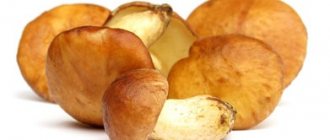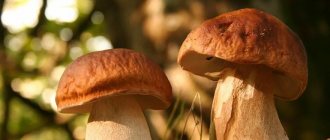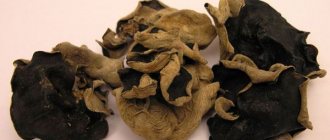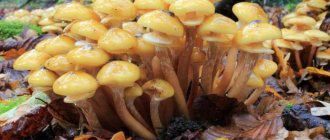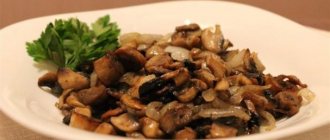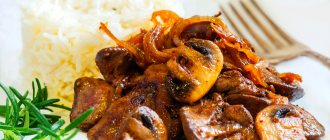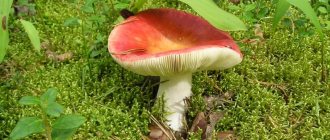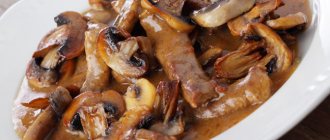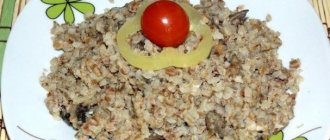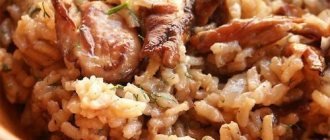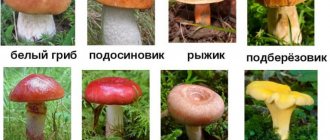The Russula family (Russula) includes about 60 species of mushrooms. Not all of them are edible. Green russula has excellent taste. The collection of these fruiting bodies requires special attention, because... doubles of this mushroom, incl. pale toadstools and false russula are classified as conditionally edible and poisonous.
Green russula
Description of green russula
Greenish russula (Russula aeruginea) has a number of characteristics that distinguish it from its life-threatening counterparts. The diameter of the mushroom cap ranges from 5 to 10 cm. In young mushrooms, it has a semicircular shape. Subsequently, it levels out and becomes disk-shaped. In young russula it is sticky. After drying, the surface of more mature mushrooms becomes elastic and shiny. The edges of the cap are slightly rounded.
The color of the cap varies from pale greenish to olive green.
The central part is darker than the edges. There is also a scaly variety of the mushroom. There are light green flakes on the surface. They are adherent to the surface.
Green scaly russula. There are light green flakes on the cap
The leg reaches 4-7 cm in height. Its diameter is 2-3 cm. It is fleshy and has no cavity inside. Its surface is smooth. The flesh is white, but when pressed it turns brown. The plates are located frequently. They are distinguished by their white or yellowish color. The spores are a creamy powder.
The pulp has a pleasant taste. It is suitable for fresh and thermally processed consumption. The pulp has a fragile structure, so even with slight mechanical stress it quickly breaks.
Boiling, salting and marinating
Before boiling, the mushrooms are carefully sorted and washed, cleaned of contaminants, placed in a saucepan, and filled with water in a ratio of 2:1. Then they put it on a medium flame until it boils, after which it is turned down, it is necessary to monitor the formation of foam, which must be removed periodically. Add salt, black peppercorns, bay leaf. Cooking time after boiling is half an hour. The water must be poured out after this.
To pickle, after placing the mushrooms in a pan (using the same preliminary steps as for boiling), add salt. Next, peel 3 cloves of garlic, from which they make small plates that are placed on the mushrooms. Cover with blueberry branches and place in a cool and dark place for 12 hours. Add sliced 1 medium onion on top, add 3 tablespoons of vegetable oil and mix, then put into jars and close. Mushrooms need to be compacted, adding new ones. After an average of 1 month, mushrooms can be consumed.
You can marinate mushrooms in different ways, the most common is with vinegar. The stems are cut off, the mushrooms are poured with boiled water, brought to a boil, allowed to cool, and then placed in a colander. Currant leaves, cherries, dill umbrellas, and bay leaves are added to the jars. The brine is made based on 250 g of water, 25 g of rock salt and 50 ml of vinegar. It is boiled and poured into jars with mushrooms. Sterilization is carried out in a pan with water. After boiling, keep on the fire for 20 minutes, then roll up the lids.
Green russula growing places
They are found in many regions, because... they are not too demanding on climatic conditions and soil composition. This variety, like its counterparts, grows in both coniferous and deciduous forests. Particularly good mushroom places, where green russula are found in large quantities, are located in birch groves. These mushrooms quickly enter into symbiosis with these trees.
Green russulas are often found in birch groves
In addition, you can often come across the mushroom under oaks and beeches. He prefers well-lit places. Fruiting bodies begin to form in late summer. The mushroom harvest continues until the end of September. Russulas in most cases grow singly, but clustered shoots are also possible.
Russula eaten raw
Russula blue-yellow (bruise) has peelable greenish or brownish skin in the middle and bluish, lilac or olive skin along the edges. I would like to call this coloring uneven. Her records are so white that they always seem clean. The pulp is very dense and may have a purple-red hue under the skin. The leg is strong or loose inside. This species is more often found in mixed, pine and birch forests. Russula blue-yellow should be classified as a universal mushroom that can not only be fried, boiled, salted, but also eaten raw. First, the mushroom is cut into pieces, sprinkled with salt and left for one day. There are lovers of raw russula who eat these russula whole, after salting the pulp with salt.
Edibility assessment
This russula is an edible species. It can be consumed even without heat treatment, but in this form it has an unpleasant aftertaste. After heat treatment it disappears. In the existing classification, this variety belongs to the fourth category. There are many recipes with this type of mushroom.
Before cooking, they must be cleaned and rinsed with special care.
Given the special fragility of the structure of russula, they are most often fried or stewed. Pickling is allowed. Young fruits, which have a denser structure, are better suited for this. After drying, the fruiting bodies become even more fragile. The dried fruits are often used to make mushroom soups.
Preliminary preparation
How to salt russulas - inexpensively, quickly and tasty
Russulas have one property - the pulp of these mushrooms, especially some of the types, tends to be bitter, so there is no way to eat them raw, and before cooking, russulas must undergo special preparation.
The rules for the preliminary preparation of these mushrooms are not at all complicated, but in order for the russula to be properly salted, they cannot be neglected
It is important to remember that each type of Russula has its own taste characteristics - some require more effort in preliminary preparation, others less - everything is decided depending on the specific type. Therefore, before you start cooking mushrooms, you definitely need to have information about the characteristics of the type of Russula that you want to cook
Fruit bodies must be carefully inspected and sorted, removing rotten, overripe or overly damaged specimens. Mushrooms should be cleaned and rinsed under running water, using a small brush to remove stubborn dirt.
The skin from the cap must be carefully removed - it is most often the source of most of the bitterness. Be careful when doing this, as the cap of the Russula crumbles easily. To completely remove the bitterness from the mushroom pulp, the fruiting bodies must be soaked in water.
The soaking period depends on the type of mushroom and can range from 6 to 24 hours. At the same time, the water must be changed approximately every 3 hours. After soaking, the fruiting bodies should be rinsed under running water. Too large specimens are cut into 2–3 parts. Small ones can be left as is. The main thing is that all the individual pieces are the same size - then they will be salted evenly. You can use enamel and glass dishes, but they don’t like iron russula and can turn black.
It is important, in the future, to follow the rules for storing homemade pickles. They are usually stored in a refrigerator or cellar, where the temperature must be maintained from 0 to +8 degrees
Also, do not forget to sterilize the jars in which you will place the russula. Violation of sterilization technology is a very dangerous thing, often leading to very unpleasant consequences. Typically, glass jars for pickles are sterilized twice - right before placing the product in them, and immediately after closing the lids.
There are many completely simple recipes for pickling russula for the winter, and this article presents some of them
Please note that some recipes use mushrooms that have already undergone special processing, while in others this processing is part of the recipe
Features of green russula and rules for collecting them
Russulas must be collected carefully so as not to damage their structure. Do not pack them too tightly into the basket, because... this will cause the mushrooms to turn into dust. Fruit bodies should not be pulled out of the ground. They need to be carefully cut with a knife, leaving a small piece of the stem in the soil. Only in this case will the fragile mycelium remain intact and still bear fruit. Before picking up the fruit, it must be cleaned of dirt and twigs. These mushrooms often grow alone.
It is important to carefully place the mushrooms in the basket so that they do not get wrinkled
If you find one mushroom, you should carefully examine the area around it. This will allow you to find many more fruiting bodies. Fruits should be placed in layers in the basket. The mushrooms should not be allowed to squeeze each other too much. Shallow baskets are best for collecting. Mushrooms are distinguished by their ability to absorb toxic substances into the pulp, so they should only be collected away from roads and city limits.
Collection rules
Mushroom pickers are lenient towards this family and if there is other prey, they leave the green variety to the less fortunate followers. Green russula, unlike other members of the family, almost does not crumble during the collection process and tolerates transportation well. They have a dense structure, which is a feature of this species.
Important! Any mushrooms should be collected away from city limits and roads, since, like a sponge, they absorb all toxic substances and therefore, despite their attractive appearance, are dangerous to health.
Harm and contraindications for consuming green russula
Green russula contain many biologically active substances, so in some cases they can harm the human body. These mushrooms, both raw and after heat treatment, are not recommended for use by children under 8 years of age. In addition, women during pregnancy and lactation should not include these fruiting bodies in their diet.
Even in the absence of these contraindications, people are not recommended to consume more than 150 g of the product per day.
People suffering from diseases of the gastrointestinal tract should not eat these mushrooms, incl. ulcer and gastritis. Consumption of russula can provoke an exacerbation of these pathological conditions. In addition, for some people, the inclusion of these fruiting bodies, which have undergone insufficient heat treatment, in the diet can provoke digestive upset, accompanied by diarrhea and vomiting.
Excessive consumption of russula can lead to undesirable consequences
Consumption of these mushrooms can cause an exacerbation of existing kidney diseases in a person. A contraindication to eating russula is kidney failure, because This product contains too much protein. The fungus can provoke an exacerbation of liver diseases.
These fruits are especially dangerous for people suffering from hepatitis and cirrhosis.
When salted and fried, these mushrooms create increased stress on the pancreas. Because of this, this product is not recommended for people suffering from pancreatitis. Various diseases of the gallbladder are also contraindications to the consumption of mushrooms.
Despite the fact that this mushroom is not poisonous, it can cause significant harm to the human body, causing severe poisoning. A similar outcome from taking russula is often observed if the mushrooms were collected in environmentally unfavorable areas, as well as near factories and highways.
Application
Due to its healing qualities and a number of vitamins in its composition, the product has found wide use in cooking and medicine. It is included in the diet when “drying” the body and intense training. The increased protein content allows you to quickly restore muscle tissue damaged during increased physical activity and improve metabolism.
Consumption of this product in an amount of 150 g/day has a positive effect on the state of the nervous system and immunity. Protein components actively restore the tissue of the walls of the vascular network, preventing their blockage (thrombosis), and promote the removal of toxins. High iron content increases hemoglobin levels in the blood.
An inedible analogue, blood-red russula, is used as a raw material for tinctures. The extract from it contains useful microelements and substances that make it possible to create homeopathic preparations.
In cooking
Russulas are consumed fried, pickled, and salted. Before cooking, the product is thoroughly washed to remove dirt. The hat is peeled by prying the edge with a knife. Lightly cut out the core.
The cleaned, prepared fruiting body requires immediate processing while the flesh is not yet yellow. It is important to prevent it from darkening. Boil the mushrooms for 20 minutes, then drain the water and add new water, boil for another 20 minutes with the addition of spices, bay leaves and onions. After such preparation, they can be fried, stewed or rolled into jars.
Raw mushrooms contain the enzyme russulin. It is used in the production of rennet cheeses and cottage cheese.
In medicine
Russula has found wide application in medicine. Traditional healers have long used it in the treatment of abscesses, ulcers and pyoderma (purulent skin lesions that develop as a result of the penetration of bacteria - pyogenic cocci) into the body. In traditional medicine, mycelium extract is used in the production of medicines for cancer patients. The mushroom is actively used in dietary nutrition in the treatment of thrombosis and cardiovascular pathologies.
The juice of the mushroom is used in the fight against corns. Russula vodka tincture is effective in treating colds. It is also used externally for rubbing. The inedible mushroom Russula causticus is suitable for the production of hemostatic drugs.
Chemical composition of mushrooms
Green russulas are considered dietary products. The calorie content of 100 g of products is only 19 kcal. These mushrooms are low in carbohydrates and fats and high in dietary fiber and proteins. The vitamins, micro- and macroelements present in this variety of russula include:
- thiamine;
- ascorbic acid;
- niacin;
- riboflavin;
- alpha tocopherol;
- iron;
- calcium;
- potassium;
- magnesium;
- sodium;
- phosphorus.
The beneficial properties of russula are also due to the presence of Omega-6 fatty acid in their pulp. In addition, this mushroom contains mono- and disaccharides. The pulp contains the following acids:
- stearic;
- palmitic;
- myristic;
- oleic;
- palmitoleic;
- linoleic
Russula pulp also contains many other biologically active components that have a positive effect on the human body.
Simple and delicious food recipes
Russula is a universal mushroom. This type can be fried, pickled, pickled, frozen for the winter and even fermented. But it is not advisable to dry it, as some varieties can be bitter.
If you brought russula from the forest, how to cook them, how long to cook? It's simple. To remove bitterness, forest gifts need to be soaked for 10–12 hours in cold water, changing it periodically. Afterwards they are rinsed, washed again and boiled for 30 minutes in salted water. Once these processes are complete, you can prepare the mushrooms according to the recipes. The water in which the russula was boiled can no longer be used, all the bitterness has gone into it.
IMPORTANT! If raw fruits do not have a pungent taste, then they can not be boiled beforehand, salted or fried immediately.
Soup
To prepare a fragrant, rich mushroom soup, you will need simple ingredients. The whole process will take 20 minutes.
Components:
- russula - 400 g;
- potatoes - 4 pcs.;
- onion - 1 pc.;
- carrots - 1 pc.;
- vermicelli - 200 g;
- greens, salt.
How to cook:
- Wash, peel and cut the fruits.
- Cut clean vegetables into cubes or strips.
- Boil the mushrooms for 15 minutes, drain the water, and place the product in a fresh one.
- Add the potatoes and cook for 10 minutes, then add the remaining vegetables.
- Season the soup with spices, add salt, and add bay leaf to taste. Cook for another 10 minutes. until fully prepared.
Fried mushrooms with potatoes
Before preparing this dish, it is advisable to peel, soak and boil the fruiting bodies (if they taste bitter). The onion should be sautéed in sunflower oil, then add mushrooms and potatoes cut into strips and fry until they acquire a pleasant golden color (10–15 minutes). Then you can add sour cream to taste, season with salt, pepper, and chopped herbs.
Salting for the winter in jars
Russulas can be salted in different ways: hot, cold, stored in barrels, jars, canned for the winter. Pay attention to the hot method - it will help save time.
Ingredients for 1 kg of mushrooms:
- coarse salt - 100 g;
- cherry leaves - 8 pcs.;
- cloves - 5 pcs.;
- black peppercorns - 2-3 pcs.
How to pickle edible russula:
- Rinse them and place them in a container with cold salted water for 3 hours to remove the bitterness.
- Pour water into a saucepan, add salt, bring to a boil. Place the fruits in it, cook for 20 minutes, constantly skimming off the foam.
- Add spices, cook for another 7 minutes.
- Place the product in sterile jars, pour boiling marinade, and seal.
Pickling
This method will not take much time, but in winter you will always have a tasty, healthy snack on the table.
Ingredients:
- mushrooms - 2 kg;
- table vinegar - 150 ml;
- onions - 3 heads;
- cloves - 3 pcs.;
- granulated sugar - 1 tbsp. l.;
- salt - 50 g;
- bay leaf - 5 pcs.;
- allspice peas - 5 pcs.
How to marinate, step by step description:
- Boil the russula in salted water for 20 minutes, constantly skimming off the foam.
- As soon as the fruits sink to the bottom, you need to throw them in a colander and cool.
- Prepare the marinade: to do this, dissolve spices, salt, sugar, and onion chopped into 2 or 4 parts in a liter of water.
- Boil the brine for 10 minutes, add vinegar.
- Place boiled russula in jars, pour boiling marinade over them, and seal with lids.
Beneficial features
Green russula contain a minimum of calories and a large amount of vitamins and minerals, so they will be a good addition to the diet of people trying to lose weight without harm to their health. In addition, avoiding fatty meats and fish in favor of these mushrooms helps reduce cholesterol and cleanse blood vessels of atherosclerotic plaques.
Eating green russula helps remove cholesterol from the body.
Biologically active components contained in the pulp of this variety of russula reduce the risk of blood clots. This product, when consumed boiled or stewed, helps cleanse the intestines and quickly remove toxic substances from the body. In addition, green russula contains compounds that have a depressing effect on pathogenic microflora and help suppress the inflammatory process in the gastrointestinal tract.
Due to the high content of protein, calcium and vitamins in this mushroom, regular inclusion of it in food helps improve the condition of the skin. Tinctures based on this mushroom can be used to treat pyoderma and abscesses. In addition, russula can be used to curdle milk to obtain a tasty fermented milk product.
Recommendations for collection, processing and preparation
Experienced mushroom pickers recommend collecting russula only in buckets or enamel baskets. The reason is that they are fragile and quickly break and crumble.
The russula can be cut and twisted - this will not harm the mycelium. The harvested crop is not stored for a long time; it must be processed immediately.
REFERENCE! To make it easier to peel the skin, you need to scald with boiling water or blanch the russula for 5 minutes. You can also soak it for a while.
Primary processing before cooking involves cleaning the fruiting bodies. To do this, carefully remove forest debris, pine needles, and cut out darkened or worm-eaten areas. It is better to throw away rotten specimens immediately.
If you come across red russula, you must definitely remove the skin from them, otherwise the finished dish will be bitter. After cleaning, they are washed under running water and placed in a colander to drain excess liquid.
Similarity of green russula with other mushrooms
Russula has many doubles. The most dangerous of them include fly agaric and toadstool. Getting a poisonous double into a mushroom picker's basket is fraught with severe poisoning and death.
The developing russula bears some resemblance to the young great grebe. The stem and cap of these mushrooms are similar, but the poisonous fruit body can be distinguished by the presence of a volva, a ring and a characteristic unpleasant odor. Ripe green russula is much easier to distinguish, because it has a clearly visible leg that does not have a ring or volva. The cap of such a mushroom becomes depressed. The cap of the pale grebe remains convex even in adulthood.
Russula can easily be confused with the poisonous toadstool
In addition, russula can be easily confused with fly agaric. Not all varieties of fly agarics have a red or orange cap. Some types of these dangerous mushrooms are distinguished by their gray-green color. However, in the fly agaric, the growths present on the cap are easily torn off, while in the russula, the scales, if any, grow in such a way that they cannot be removed without severe damage to the cap.
First aid for russula poisoning
The main actions in case of poisoning with Mair's mushrooms should be aimed at removing toxic substances using gastric lavage and enemas.
You should proceed as follows:
- Drink in small sips about 1 liter of warm water diluted with potassium permanganate until pink.
- Touch the root of the tongue with your fingers to induce vomiting.
- Continue to drink water and induce vomiting until the vomit is clear and free of food and bile.
- Take activated charcoal and lie down to regain your strength.
You need to continue to drink water little by little to avoid dehydration. A decoction of herbs such as chamomile, peppermint and juniper berries is suitable.
Related species
There are many varieties of these mushrooms found in nature. Russula stinging, which is classified as conditionally edible, is often found in forests. These mushrooms are distinguished by the presence of a light red, convex cap. The stem and plates are pinkish-beige in color. Thanks to this color, this variety is difficult to confuse with green. The pulp is soft and fragile. She is white. Often mushroom pickers put it in a basket, mistakenly considering it a fibrous or edible variety of mushroom.
Russula stinging has an extremely unpleasant taste and a light fruity aroma. This type requires long-term heat treatment. It eliminates bitterness. This variety cannot be eaten raw, because the pulp contains muscarine, which is a powerful toxin that can cause severe poisoning in humans. After prolonged heat treatment, some of the toxic substances disintegrate, so the fruit can be eaten in small quantities.
Stinging russula has a light red cap
Another common member of the family is the acute russula. It is found more often in coniferous forests, because capable of entering into symbiosis with pine. This fruit has a neat cap, reaching 3-7 cm in diameter, distinguished by its cherry color. The pulp has a light fruity aroma. She is white. The taste is acrid. The peel does not come off well. The leg is pinkish-purple in color. This variety contains muscarine and therefore requires long-term heat treatment. The mushroom is classified as conditionally edible.
Blood-red russula is also often found in deciduous and coniferous forests. The cap reaches 10 cm in diameter. At first it has a convex shape, and then becomes disk-like. Its surface is deep red. The peel does not come off well. The pulp is white and dense. The mushroom should not be consumed raw, as it has an unpleasant bitter taste. Without heat treatment, this variety can cause digestive upset. After prolonged cooking, the pulp becomes suitable for consumption.
Blue-yellow russula is found in both deciduous and coniferous forests
Edible varieties of mushrooms include blue-yellow russula. The color of its cap varies from gray-green to purple. It has a semicircular or flat shape. The leg has a cylindrical shape. Its surface is slightly wrinkled. The pulp is fragile and juicy. It has a pleasant nutty taste. This species is found in both deciduous and coniferous forests.
Another edible related species is the gray russula. The color of the cap varies from reddish-orange to yellow-brown. The peel is difficult to remove. The leg has a dense structure. In a mature fruit it is gray in color. The pulp is white and has a pleasant sweetish taste and mushroom aroma. This variety of russula is found mainly in pine forests.
Inedible
Let us immediately note the inedible types of russula, of which there are not many. These mushrooms are not poisonous, but the bitterness they contain gives the right to classify them as conditionally edible. The pungent taste is removed by certain types of pre-treatment: soaking or boiling, but eating raw is out of the question.
- Russula is hotly pungent - a mushroom of light pink or bright red color. The difference from other types is an easily removable film on the cap, the removal of which reduces the bitter taste.
- Russula is fading, less saturated in pink-red color than the previous mushroom, but also has a persistent bitterness.
- The blood-red one is distinguished by the mentioned color of the cap, and the leg of this species is also painted bright pink.
- Russula Meira looks like red, only with bitterness, another difference is that it crumbles a lot.
- Russula is a violet or lilac mushroom with burning pulp.
- Birch russula - light pink with an easily removable film, as the name suggests, grows in birch plantings.
The unifying quality of inedible russulas, they are also incorrectly called false russulas, is their bright coloring, as if screaming about danger. But as mentioned above, after appropriate processing, mushrooms are edible.
Folk signs
It is very important to understand that folk signs are not always able to help you determine whether a mushroom is poisonous or not. There are several common misconceptions that can really cost the life of a careless mushroom picker:
- All poisonous mushrooms have an unpleasant smell, but edible ones have a pleasant smell. Pale grebe is very often similar in smell to champignons, and some of the species have no smell at all, so this sign cannot be considered correct.
- Insect larvae never live in poisonous mushrooms. In fact, this is not true; the larvae of some insects feel quite comfortable even in a poisonous mushroom.
- All mushrooms, if they are young, can be eaten. Let's not judge all mushrooms, but toadstool is deadly at any age.
- If you make a decoction of a poisonous mushroom and put silver in it, the silver will definitely turn black. The range of toxic substances contained in various poisonous mushrooms is very diverse. It is possible that some mushrooms affect silver in this way, but this does not mean that this remedy can be considered the correct way to find out whether a mushroom is poisonous or not.
Gray row - description and photo
In September - October (or even in November, if the weather permits), many mushrooms with gray caps are sometimes found in our forests.
They can grow alone. But other specimens are always found nearby. They can grow in “clumps”, literally piling up one on top of another. Can form “witch rings”.
Because of the gray color of their caps, these mushrooms are sometimes called “little mice.” The Russian scientific name is gray row. And since the surface of the caps, especially those of large fruiting bodies, is covered with a network of cracks, a kind of “hatching”, the mushroom is also called hatching.
This mushroom is not only completely edible, but also has a pleasant taste and aroma. And preparing a gray row is quite simple.
The gray row is not at all a close relative of the purple row, which I already wrote about. These mushrooms belong to different genera of the Ryadovkov family. The Latin names of mushrooms record this fact very accurately.
The violet row belongs to the genus Lepista, and in Latin it is called Lepista nuda. Gray rower is a representative of the genus Tricholoma, its Latin name is Tricholoma portentosum.
Gray row mycorrhiza forms with Scots pine, and grows in forests where this tree is found. True, I have not yet seen this mushroom in clean pine forests. But in coniferous-deciduous forests, where pine, spruce, birch and aspen grow, rows of sulfur can sometimes be collected quite a lot.
The row is gray (hatched) - the mushroom is quite large and dense. The diameter of the cap ranges from 5 to 15 cm, and the length of the rather thick stem reaches 10 cm or more. True, most of this long leg is usually hidden in moss or in the forest floor.
The cap is initially bell-shaped and later becomes prostrate. There is no pronounced tubercle in the center of the cap. The top of the cap is covered with gray skin. This skin, especially on large mushrooms, cracks and creates a peculiar pattern (“hatching”).
On the underside of the cap there is a spore-bearing layer (hymenophore) of thick and rather sparse white plates. In old mushrooms, the plates may turn yellow. The plates not only do not run down onto the leg - they do not even reach it a little.
The leg is long, often curved, quite thick and dense. The base of the leg is slightly thickened. There is usually no cavity inside. It can only appear on an old fruiting body.
Gray row has a rather pleasant smell. They write about the smell of “fresh flour.” I don’t know, but it just seemed like a not very pronounced “mushroom aroma” to me. In any case, this mushroom does not have any rather pungent and unpleasant odor.
What mushrooms are similar to sulfur row?
Attentive readers of my blog probably know that I am not a supporter of the “fairy tale about false mushrooms” that is widespread on the Internet. They say that every edible mushroom has a very similar double - a “false mushroom”. And terribly poisonous! All he does is to watch and poison the mushroom picker! Such are the horrors...
Only all these horror films are, I repeat, fairy tales (or, to put it more firmly, one of the “mushroom myths”). All these “false whites”, “false boletuses”, etc., with which many Internet authors scare us.
You just need to look more carefully at the mushroom and remember its features. Nowadays, almost everyone has a camera on their phone. Take it off and look it up on the Internet. You will definitely find it.
One day was enough for me to get acquainted with the sulfur row. I found it in the forest - took a photo - looked it up in the guide - checked my guess on the Internet. There is a good group on Facebook - that’s what it’s called
“What kind of mushroom?”
. Advanced users and competent experts will definitely give you advice. If only your photos were informative.
There are still mushrooms similar to the sulfur row in the forest. What unites them is not only the gray color of their hats. All of them belong to the genus Tricholoma. But each of these mushrooms has its own characteristic distinctive features.
The edible earthy row is smaller and thinner than the gray row. And her records are not white, but gray.
The inedible soap bark has a sharp, unpleasant odor, which is why it got its name. And her plates are greenish.
The inedible (or even slightly poisonous) pointed row is distinguished by a pronounced characteristic tubercle crowning the middle of the cap. The sulfur row does not have such a tubercle. And the taste of the pointed row is pungent and pungent.
How to distinguish false duplicates of russula?
Some mushrooms are often disguised as edible russula, so all lovers of quiet hunting should know them and not confuse them with healthy fruits, and correctly identify dangerous species. Pay attention to the difference between them in the photo, and more detailed characteristics of the twins can be found in the table:
| Russula name | Differences | Places and times of growth |
| Blood red, sardonyx | Bright blood color, can be crimson, scarlet, carmine. If the weather is hot, the hat may fade. The skin is sticky and shiny. The leg is cylindrical, club-shaped, and pink in color. The pulp is dense, the taste is sharp. | Grows in sandstone, pine and mixed forests. Growing time: late summer - mid-autumn. |
| False pungent | The color range of the cap ranges from lilac to light purple, the center is often black. The leg is pink or purple. The pulp is yellow and acrid-bitter. | Temperate latitudes of Eurasia, prefers sandstones in coniferous and pine forests. Grows in late August - early October. |
| Berezovaya | The cap is white, yellow, sometimes purple, its diameter is 3–7 cm. The surface is slippery and becomes matte when it dries. The leg is white, 3–9 cm in height, brittle. | Wetlands near birch forests. Growing time: June - early October. |
Signs of poisoning and first aid
When collecting russula, you must constantly carefully monitor so that no poisonous species gets into the basket. If, however, poisoning occurs, the person who consumed the mushrooms became ill, nausea, vomiting, and headache appeared, then it is necessary to be able to provide first aid:
- Calling an ambulance is the main thing to do. You cannot self-medicate.
- Rinse the stomach using a weak solution of potassium permanganate and induce vomiting.
- Give sorbent: activated carbon, Enterosgel.
- Provide the patient with plenty of fluids: still water, you can add a couple of drops of lemon.
- Lay the victim on the bed, cover with a warm blanket.
Russulas have many varieties: edible, conditionally edible, inedible. In appearance they can all be very similar.
Where does the toadstool grow?
The pale grebe loves moisture very much and after rain a huge number of them appear. It appears quite rarely in countries with arid climates, as well as in areas characterized by dry, hot weather. The mushroom prefers mixed and deciduous forests, but this does not mean that it cannot be found in coniferous forests. Mushrooms reach their peak of development from the second half of August until October.
The birthplace of the pale grebe is Europe, after which it penetrated into Asia and Africa, spreading throughout America and Australia. In fact, the pale grebe is not so common, but nevertheless there are many places that it prefers to live. The pale grebe feels best next to oaks, chestnuts, birches, maples, lindens, hazels, beeches, and elms. But it was also noticed next to conifers: fir trees and pines. The pallid grebe is also now spreading throughout the world; recently it has become noticeable that it is finding trees as partners that were previously unusual for it. For example, the pale grebe is now doing quite well in Iran, where it grows next to and has even been seen in Algeria, where it uses.
Description of signs of poisoning by toadstool
When fungal particles enter the digestive tract, intoxication of the body begins. The liver and kidneys take the main blow: their cells are destroyed under the influence of the poison, which leads to failure of these organs. If urgent measures are not taken and the person is not sent to intensive care, a tragic outcome may be inevitable.
The first signs of poisoning with toadstool make themselves felt within 12 hours:
- abdominal pain;
- constant nausea and vomiting;
- bloody diarrhea;
- visual disturbances;
- problems with coordination, loss of strength up to loss of consciousness.
If at least one of these symptoms appears after eating mushrooms, you need to call an ambulance: delay can cost your life.
Before receiving medical help, you can take the first steps:
- Rinse the stomach with warm and boiled water, inducing vomiting after drinking 5 - 6 glasses. Repeat several times.
- Give the victim a laxative.
- Do an enema to flush out toxic food debris from your intestines.
- Put the patient to bed and make sure that he does not eat anything.
It is noteworthy that after toadstool poisoning, 4–5 days after the onset of the disease, the so-called “false recovery” occurs: the patient feels much better within 1–3 days. Then his condition deteriorates sharply again.
